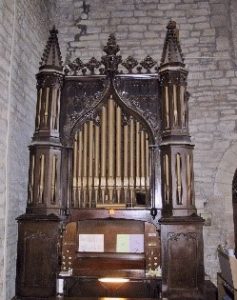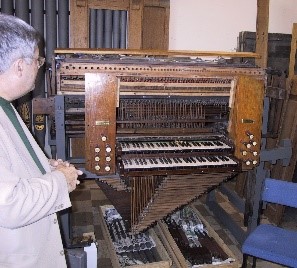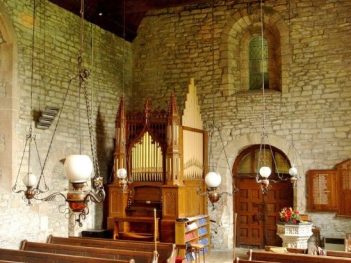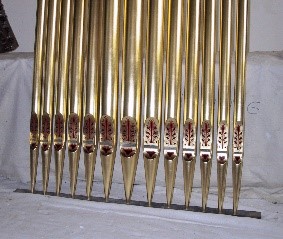 The organ is believed to date from the first half of the 19th century, but there are no records of its history before it arrived at Hartpury in 1899, gifted to the church by Mrs Gordon Canning of Hartpury House. Opinions differ as to whether it was originally one or two manual, but if one, then it must have been substantially rebuilt and the soundboard replaced before it came to Hartpury, (pictured here before the 2004 restoration) when the specification was recorded as:
The organ is believed to date from the first half of the 19th century, but there are no records of its history before it arrived at Hartpury in 1899, gifted to the church by Mrs Gordon Canning of Hartpury House. Opinions differ as to whether it was originally one or two manual, but if one, then it must have been substantially rebuilt and the soundboard replaced before it came to Hartpury, (pictured here before the 2004 restoration) when the specification was recorded as:

During the early years of the 20th century the organ was maintained by Sweetland of Bath, so it may have been supplied by them, although no records of this exist. Hartpury then had a large choir and in 1906 the organist’s annual salary was raised from £10 to £20. Such lavish expenditure was made possible by a generous yearly contribution from Mrs Gordon Canning. She was daughter and joint heiress of Welsh ironmaster Crawshay Bailey, who in 1879 had rebuilt the Parish Church of Llanthewy-Skirrid. The family was clearly in the habit of supporting the church and its music.
By 1911, parish records reveal dissatisfaction with the organ. It was not replaced however, as intended, but rebuilt by Price of Cheltenham and moved in 1926 from the chancel to its present location at the west end of the nave. It was at this time that various alterations were made to ‘romanticise’ the instrument. The 4ft.principal was removed from the Swell and replaced with the 8ft.salicional, and pneumatic action to the Great open diapason was fitted. The placing of these zinc pipes on the side of the organ detracted from the original case and also concealed the wooden pipes bearing attractive stencilling, that may previously have formed a facade. Nonetheless the case was thought worthy of discussion by Rev. Andrew Freeman in an article in the October 1938 issue of ‘The Organ’. He records the specification after the 1926 enlargement as:

In 1958, Osmond & Co. of Taunton overhauled the instrument, and took advantage of the recent installation of an electricity supply to the church by fitting an electric blower to provide wind to the bellows. Unfortunately this necessitated cutting into the lower panelling of the organ case. Osmonds continued to maintain the organ and again overhauled it in 1985 including carefully re-palleting the soundboard.
In 1999 John Bleney of Worcester overhauled the instrument, paying particular attention to the Great pipework and rackboards, but it was becoming clear that major work was necessary if the organ was to continue to serve the village into the new century. After extensive consultation the decision was reached to commission a complete rebuild, giving thought to reversing a number of the 1926 alterations. At the same time, the fine early Victorian neo-Gothic organ case would receive the benefit of long overdue attention. Many of these fine cases have been discarded over the years and it is rewarding to see one returned to its original glory. Further research may even disclose the original builder, because identical stencilled designs were to be found on pipes of a former organ at St Peter, Upper Gornal, Dudley.
2004 restoration
 Trevor Tipple of Worcester undertook the work. In 2004 his firm completely dismantled, repaired, cleaned and rebuilt the instrument.
Trevor Tipple of Worcester undertook the work. In 2004 his firm completely dismantled, repaired, cleaned and rebuilt the instrument.
At the same time the opportunity was taken to undertake certain modifications intended to give the organ the brighter sound that would have been apparent prior to the 1926 work.
The specification after the 2004 rebuild:

Huning Decorations of Bath uncovered and restored the true beauty of the case, assisted by local cabinetmaker Roy Rhodes of Ashleworth. The damaged elements on the front panel and pinnacles of the organ case were repaired or replaced using casts taken from surviving elements and the entire casing regrained in the style of the original.  The decorative front pipes were regilded church using 23½ carat gold. Designs in red and black were found on the pipes, underneath bronze overpainting, and these designs were recreated on the newly gilded pipes.
The decorative front pipes were regilded church using 23½ carat gold. Designs in red and black were found on the pipes, underneath bronze overpainting, and these designs were recreated on the newly gilded pipes.
A new side panel was constructed replacing the panel that had been cut to take the blower. At the same time a pillar was added to the right, which provides a better fixing for the horizontal bar supporting the zinc pipes of the Great Open diapason. The appearance of these pipes had been unsatisfactory and the mounting insecure from the time they were added. The pillar now provides a better balance as well as increased stability. A colour was selected for the large pipes to minimise their impact, which had detracted from the splendour of the front face. A design found on the pipes that had previously formed this facade was gilded onto their mouths, with an additional small motif added to the tops.
